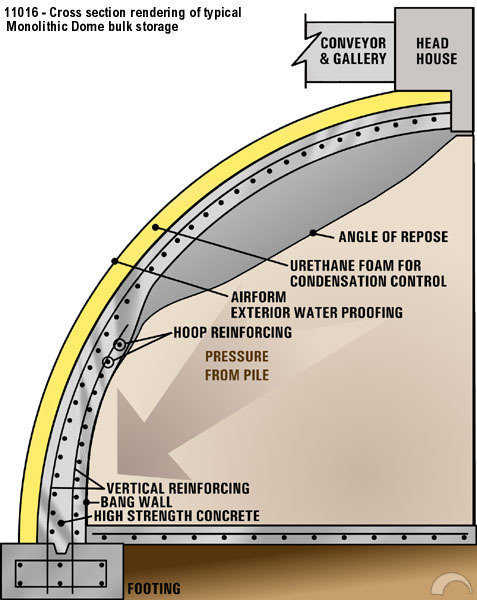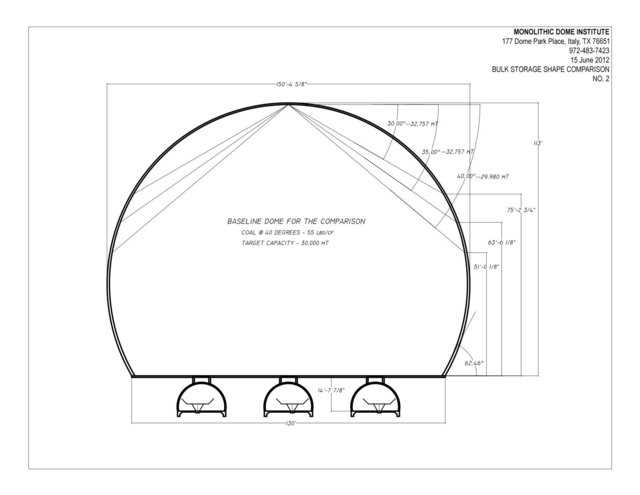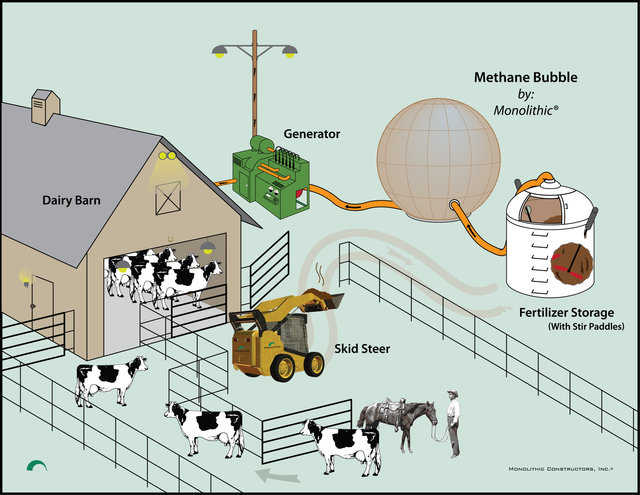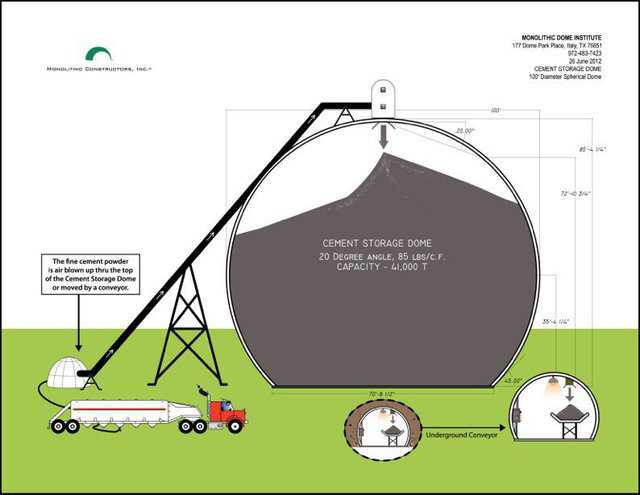Your dollar buys more when you invest in a Monolithic Dome bulk storage facility. Not only can you get exactly what you need for less, but you can get it designed and built by experienced, reliable and reputable professionals.
Monolithic built its first storage unit in 1976 — a 105′ × 35′ concrete dome to hold Idaho potatoes. Since then, more than 500 Monolithic Dome storages have been built and are in use in nearly every American state and more than 20 foreign countries. Besides potatoes, they store cement, sand, salt, fertilizer, feed, grains, fruits, vegetables, aggregates, carbon, chips, seeds, peanuts, Coke, blasting powder, etc.
In size, these domes range from the smallest with a 40’ diameter to the currently largest that measures 300′ × 165′. Their storage capacities vary from a few hundred tons to many thousand tons.
Advantages
Lower Construction Costs – The very shape of a Monolithic Dome contributes significantly to its affordability. A dome requires the smallest surface area and employs the least amount of materials to enclose space. If you compare the holding capacity of different kinds of bulk storages to that of a Monolithic Dome, you will find that the dome can easily store as much as any of the others, but it can do it in less space. Consequently, the dome provides your desired storage capacity but saves on construction costs and land use.
That makes a Monolithic Dome bulk storage a better bargain than a vertical silo, an A-frame, or a flat unit, whether it’s constructed of concrete, wood, steel or aluminum.
Basic Foundation – Generally, a Monolithic Dome bulk storage does not require a foundation as thick as one for a vertical silo. Reason: Stored material falls away from the walls of a dome and spreads, so much of the pressure stays in the middle of the dome and on the ground. Thus, a huge Monolithic Dome bulk storage, even in moisture-compromised areas, may require only a simple, basic foundation instead of a super-thick, costly one.
Timely Construction – In Monolithic Dome construction, once the Airform is inflated and stabilized, the building process continues on the inside of the dome, unaffected by either light or weather. Construction usually can proceed whether it’s day or night and in fair or foul weather.
And since the materials used to build a Monolithic Dome are generally available almost everywhere, delays encountered when you must wait for supplies are averted.
Design Flexibility – When it comes to shapes and sizes, Monolithic offers a generous variety, and its professionals can help you decide which dome size and shape can best fit your needs and your budget.
Every Monolithic Dome features a clear-span interior, uninterrupted by columns or posts. That clear interior maximizes the dome’s holding capacity.
To efficiently move materials, a conveyor system and/or a tunnel system, in the length you need and built either below or above ground, can be incorporated in the dome’s design. An automated reclaim system can also be included.
Superior Strength – Monolithic Dome construction uses a patented process and only high-grade materials: a tough outer skin or Airform, a shell built of Shotcrete reinforced with hoops of steel, and a sprayed insulation of polyurethane foam.
This construction method, plus the materials, plus its curved shape give the Monolithic Dome its unbeatable strength. The outside top of a Monolithic Dome can support huge loads, and its interior underside can hold huge attachments: head house, diverter, bag house, conveyor, equipment, etc.
A Monolithic Dome can safely contain huge amounts of pressure against its walls that’s exerted by the tons of material stored within it. Example: Cement piled 120 feet deep can exert a pressure of more than 5 tons per square foot at the dome’s base. The Monolithic Dome can handle that and more. Its hoops of rebar — sometimes as much as a million pounds of reinforcing steel — make that containment possible.
Minimal Condensation – A Monolithic Dome’s concrete shell is completely enclosed by a sprayed-on, thick blanket of polyurethane foam insulation. That super insulation on the shell’s exterior minimizes condensation on its interior. Less condensation means less spoilage.
Corrosion Resistance – Condensation that develops in a bulk storage often produces corrosion. The Monolithic Dome’s single-ply roof membrane (Airform) and insulation form a waterproof exterior, eliminate leakage and minimize condensation and corrosion. Then too, a Monolithic Dome’s concrete is denser and more chemical resistant than conventional concrete, and additives can be used to further increase its corrosion resistance.
Efficient Loading and Unloading – A Monolithic Dome stores goods in a tall, curved pile rather than a horizontal, rectangular one. So, material stored in a dome pours out more quickly and eliminates or minimizes using front-end loaders.
Ideal Bang Walls – Built of high-density concrete, the lower portion of a Monolithic Dome can resist front-end loaders banging into it and the scraping action of the loader bucket.
Easily Maintained Temperatures – Thick layers of sprayed-on polyurethane foam insulate a Monolithic Dome and convert it into a self-contained, thermal battery that can easily reach and maintain a required temperature — regardless of what that requirement may be.
Multi-use – When not used to hold a specific product, a Monolithic Dome bulk storage can be used as a shop or to house costly equipment. The dome can even be converted into a blend plant.
Survivability – Monolithic Domes can and have withstood natural, as well as manmade, destructive forces. They meet or exceed FEMA’s specifications for structures that can provide near-absolute protection from tornadoes and hurricanes. The domes can also withstand earthquakes and resist fire, termites, vermin, mold, mildew and rot. Rifle bullets cannot penetrate a Monolithic Dome’s concrete, and Monolithic Domes in war-torn areas have survived explosives.
Lower Insurance Premiums – A Monolithic Dome’s ability to survive natural and manmade disasters, including fire, make it a prime candidate for low insurance rates.
Longevity – The lifespan of a Monolithic Dome is measured in centuries, not years. The dome needs only a reasonable amount of care and maintenance to be of continual use for many years.




